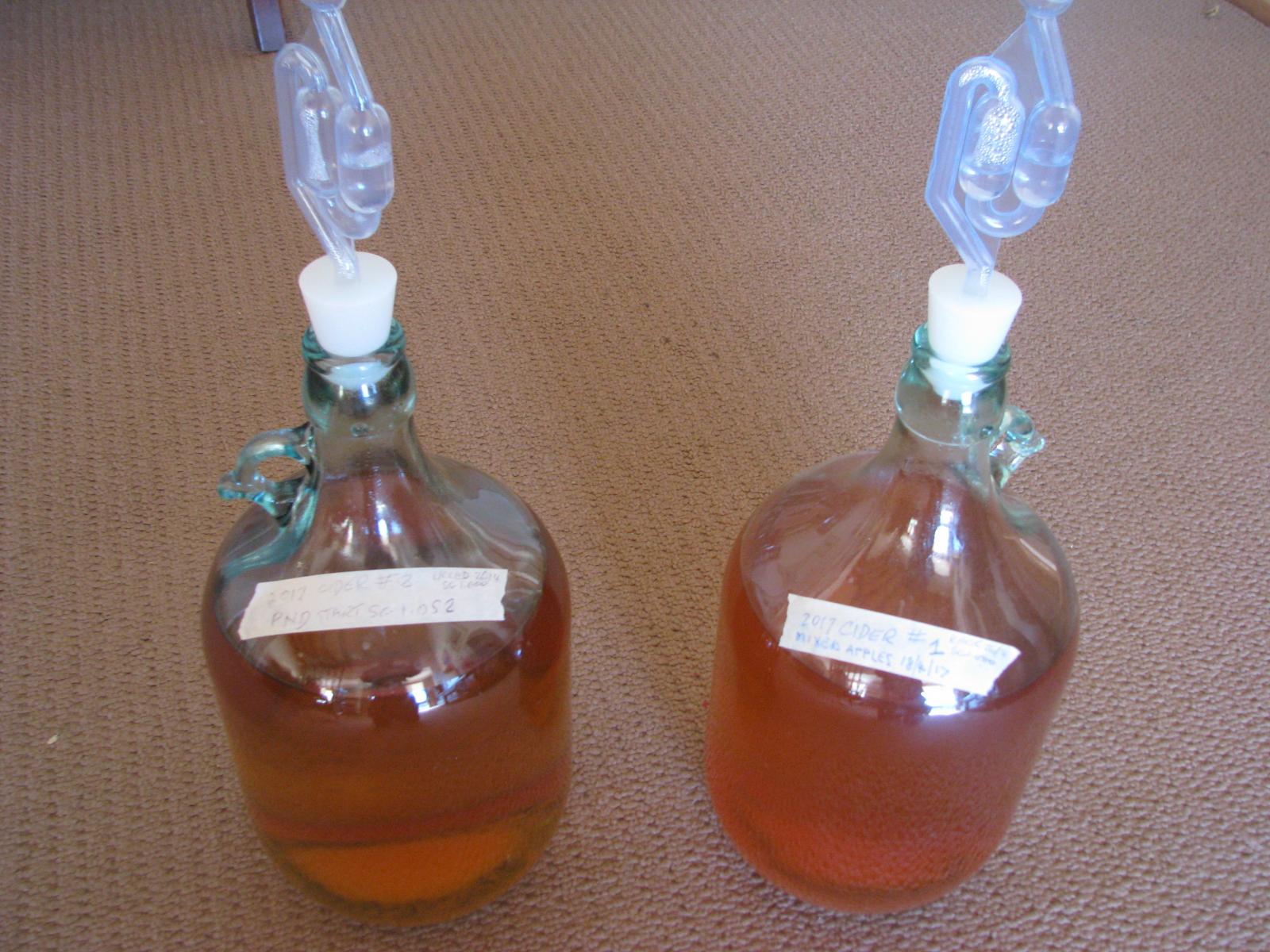There has been a lot of discussion about sweetening, carbonation etc lately, so here is my situation. I am keen to get some advice on which way to go having had some poor results in the past from leaving the cider on the lees for too long and not adding sugar for back carbonation.
As outlined in an earlier post, I have two 5 litre (one gallon) batches. Both from juiced fresh apples and allowed to sit for a day to let the pulp etc settle out. They had no added sugar (starting SG was 1.060 and 1.070) and went through primary fermentation quickly (dropped to 1.000 in six days) using Safcider yeast as recommended by the local brew shop (well 200km away in Canberra is local to us). The batches were stored for fermentation in a cupboard that houses the hot water system. The cupboard temperature is a fairly constant 70-72 degrees F (20-22 degrees C.
Both batches have now been racked into secondary and have cleared with only a small amount of sediment (around 1/8 -3/16 inch) settling in the bottom of the carboys to date. They have been sitting back in the cupboard for 10 days. I do have the option of moving them to our produce cool store which is 60-64 degrees F (15-18 degrees C)
.
The plan was (is) to bottle in about another three weeks (the end of May, which is the start of Winter) although some websites suggest it is worthwhile doing a tertiary racking for several months before bottling.
Bottling and back sweetening appears to be yet another can of worms. It seems that Stevia or Xylitol are the choices for sweetening if I want fizzy cider. The plan was to carbonate by adding a teaspoon of sugar to each 500ml (1 pint) bottle. A test using just water and sugar shows that this results in SG of 1.005 then adding a sprinkle of yeast and bottling gives a nice fizz after a couple of weeks.
However some recent posts have suggested adding the sugar to the carboys and mixing it into the brew before bottling. I also have the option of adding fresh juice plus sugar to achieve the same result.
When it is all over I plan to cooktop pasteurise the bottles.
So after all the verbiage and waffle, I would welcome opinions on
- Yeast. I used Safcider but for the future I also have some EC1118 and it looks as though Nottingham is popular.
- Fermenting temperature (warmer or cooler)
- Tertiary racking (some web sites just suggest bottling as soon as fermenting is done)
- What to use for back-sweetening if I also want a fizzy brew
- Adding sugar for carbonation (white sugar, brown sugar, juice?) to bottles or to the brew
Thanks for your patience and advice. This forum is the best source of practical wisdom I have come across.
Cheers!
As outlined in an earlier post, I have two 5 litre (one gallon) batches. Both from juiced fresh apples and allowed to sit for a day to let the pulp etc settle out. They had no added sugar (starting SG was 1.060 and 1.070) and went through primary fermentation quickly (dropped to 1.000 in six days) using Safcider yeast as recommended by the local brew shop (well 200km away in Canberra is local to us). The batches were stored for fermentation in a cupboard that houses the hot water system. The cupboard temperature is a fairly constant 70-72 degrees F (20-22 degrees C.
Both batches have now been racked into secondary and have cleared with only a small amount of sediment (around 1/8 -3/16 inch) settling in the bottom of the carboys to date. They have been sitting back in the cupboard for 10 days. I do have the option of moving them to our produce cool store which is 60-64 degrees F (15-18 degrees C)
.
The plan was (is) to bottle in about another three weeks (the end of May, which is the start of Winter) although some websites suggest it is worthwhile doing a tertiary racking for several months before bottling.
Bottling and back sweetening appears to be yet another can of worms. It seems that Stevia or Xylitol are the choices for sweetening if I want fizzy cider. The plan was to carbonate by adding a teaspoon of sugar to each 500ml (1 pint) bottle. A test using just water and sugar shows that this results in SG of 1.005 then adding a sprinkle of yeast and bottling gives a nice fizz after a couple of weeks.
However some recent posts have suggested adding the sugar to the carboys and mixing it into the brew before bottling. I also have the option of adding fresh juice plus sugar to achieve the same result.
When it is all over I plan to cooktop pasteurise the bottles.
So after all the verbiage and waffle, I would welcome opinions on
- Yeast. I used Safcider but for the future I also have some EC1118 and it looks as though Nottingham is popular.
- Fermenting temperature (warmer or cooler)
- Tertiary racking (some web sites just suggest bottling as soon as fermenting is done)
- What to use for back-sweetening if I also want a fizzy brew
- Adding sugar for carbonation (white sugar, brown sugar, juice?) to bottles or to the brew
Thanks for your patience and advice. This forum is the best source of practical wisdom I have come across.
Cheers!



